Abrasive manufacturers are discovering Colback nonwovens to be an ideal backing for abrasives. Colback is straightforward to process and the final product properties are much appreciated by end-users.
A coated abrasive consists of a few components: the backing, a base coat, the abrasive grit, a size coat and a finishing coating. The backing literally carries the abrasives and plays a crucial role during the abrasive manufacturing and in the final product performance. The unique Colback technology ensures consistent high-end performance both during manufacturing as well as throughout the lifetime of the end-product.
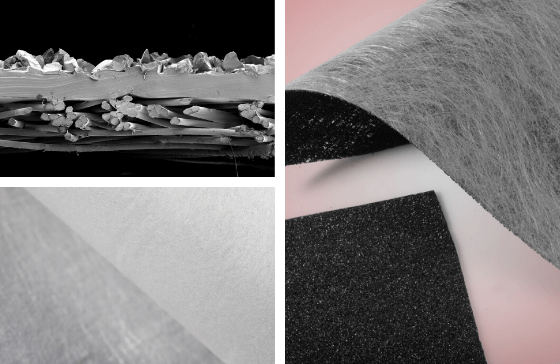
Abrasive manufactures like Colback because it is:
- Uncomplicated to print on
- Quick to impregnate with multiple coatings and resin types
- Uniform, isotropic and offers excellent dimensional and thermal stability
- Highly tear resistant yet offers easy dust-free and non-fraying cutting
Colback can be used for most abrasive types; from belt to rolls, strips and discs.
Extensive and continued testing in close collaboration with external partners has shown Colback to be an excellent platform for face masks and respirators. Colback nonwovens have unique features for trouble-free processing and they significantly improve the stability of the masks.
In respirators and (non-medical) face masks, Colback is used as a reinforcing layer which improves the stability helping to maintain the mask shape during service life. Colback’s high air permeability contributes to better breathability and comfort. With Colback, face masks will typically weigh less than average, also adding comfort during use. As separate inserts for non-medical pocket masks, Colback Plus offers a high filter efficiency combined with excellent breathability. Cup-shaped respirators can benefit from Colback’s outstanding moldability even at lightweight.
Additionally, manufacturers recognized that Colback nonwovens are very easy to process. Colback is simple to cut, laminate, pleat, mould and stitch which is crucial for efficient production.
Learn more about Colback Nonwovens as Functional Layers in Face Masks
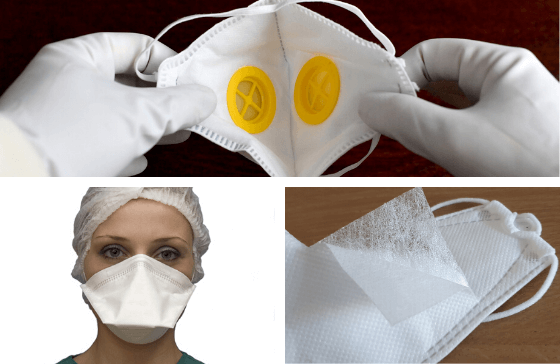
Colback nonwovens help to manufacture face masks and respirators that are safe and comfortable yet efficient to produce.
Key features:
- High stiffness even at low weights
- Easy to cut (also complex shapes) without fraying or curling
- Ideal to laminate both ultrasonic and thermal
- Perfect for molding even at low temperatures
- Straightforward sewing and ultrasonic bonding
Colback nonwovens print and handle as easy as paper without having the limitations of paper.
Apart from printing, dying and painting – you can just as easy laminate, cut, pleat and emboss it! What’s more? Things that are very hard to do with paper are no challenge for a strong nonwoven like Colback. sewing, embroidering and even 3D molding.
Colback can be as isotropic and stiff as paper but it does not tear or wrinkle. It is easy to cut but “water-proof”. Lastly Colback is a “textured” material which adds a unique look to any print.
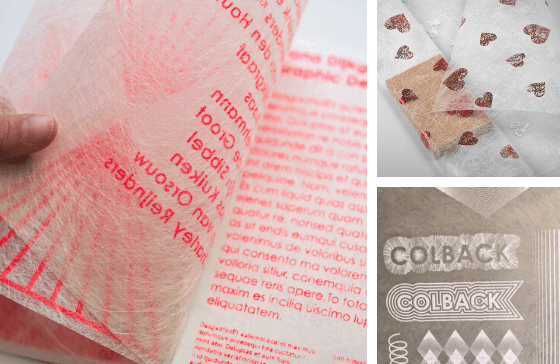
Thanks the highly versatile Colback technology – we can design a nonwoven that is optimized for your specific process parameters and application requirements. Colback can be tailored to best fit a specific print or dye processor to get the desired look. Colback can be used for printing posters but it is also perfect for creating exclusive wallpapers. It is dyed and printed but also embossed, coated and even embroidered resulting in a unique and exclusive look.
Manufacturers like Colback because it handles easily and allows for additional processing steps. End-users also like printed Colback because of its easy handling but also for the unique look.
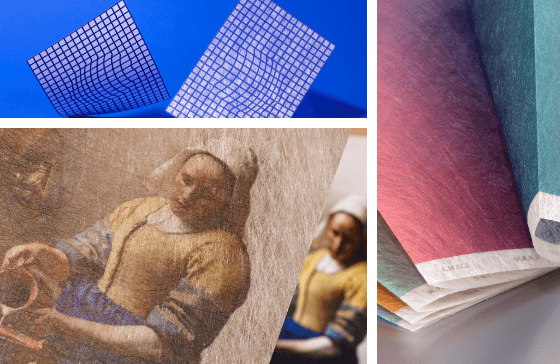
“Hard” features:
|
“Soft” features:
|
Colback is not like any other nonwoven and over time Colback’s unique look and features have inspired artists and even fashion designers to make great creations.
Manufacturers love Colback because of its uniformity and predictable behavior batch after batch and year after year. Artists however, love Colback because of its unique look and because they can perform a range of operations on Colback that they could not do with any other fabric and certainly not with common nonwovens. Cutting, molding, painting, pleating, melting, sewing, printing – think of it and it can be done with Colback. The general feedback is that Colback is a beautiful fabric with a unique look that handles as easy as paper but without the limitations of paper and offers more processing options!
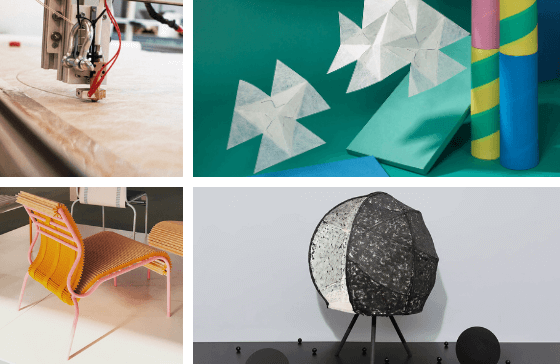
The creations were displayed in multiple shows. It has especially been an eye-catcher at the famous Dutch Design Week in Eindhoven (Netherlands) inspiring designers from all over the world.
So even if you are not an artist and you just want to get an understanding of Colback’s features – do check out the pictures and get informed and inspired in one go!
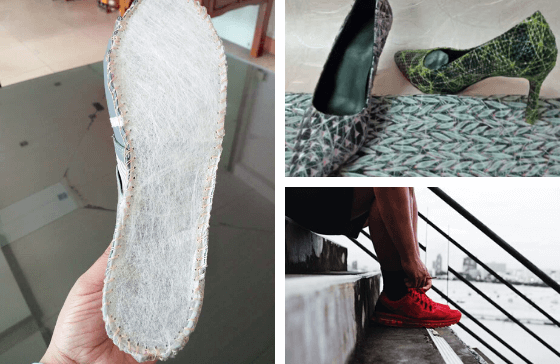
Slowly but gradually the apparel industry is discovering the benefits of Colback.
Colback is stiff, thin and tear resistant yet very easy to cut, mold, laminate and stitch. All features which are important to apparel and (sport)shoe designers and manufacturers.
Manufacturers like Colback because it is so easy to process. Designers appreciate Colback because its features allow them to come up with new designs. They use Colback to reinforce, support and strengthen fabrics and leather in clothing, (sport)shoes and hats.
Artificial turf is a perfect solution for sport fields that are used intensively and it is a great alternative when the climate is not optimal for natural grass.
Heavy use and though climates require an even tougher artificial turf mat. One key requirement is that the turf mat stays in place and does not deform in any way. The field size and the intensive use make this a real challenge.
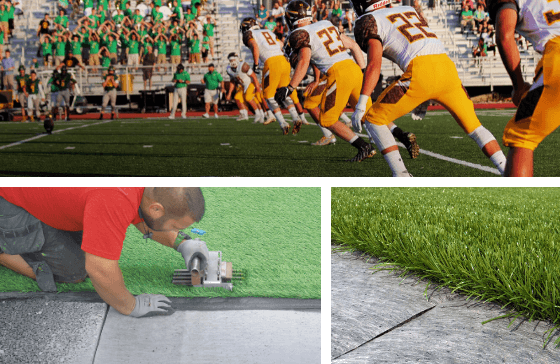
To meet this challenge, manufacturers use Colback to reinforce the artificial turf backing. Colback is ideal because it is easy to process, tear resistant, isotropic very dimensionally stable and Colback has a high tensile strength.
For the same reasons installers claim that working with Colback reinforced artificial turf is easier. Even on long lengths the mat positioning is precise and easy to finish.
Colback manufacturing started in the late 60’s. The Colback technology was unique and provided a design flexibility that even today is still unrivaled in the nonwoven industry. Tensile strength, stiffness, elongation and surface tension are just a few examples of the many properties that can be tailored.
Over time Colback has been used in a variety of industries in numerous processes and applications. Some of these applications were truly unique. These applications were thought of by out-of-the-box thinking minds looking for solutions. They made use of Colback’s unique features and designable properties to solve their specific challenge. Do check out these applications. Maybe there is one that sparks your imagination helping you to a solution that you were not aware of before.
Would you like to discover what Colback can do for you? Simply contact the local team by mail or phone and together we will find the best solution to your challenge.
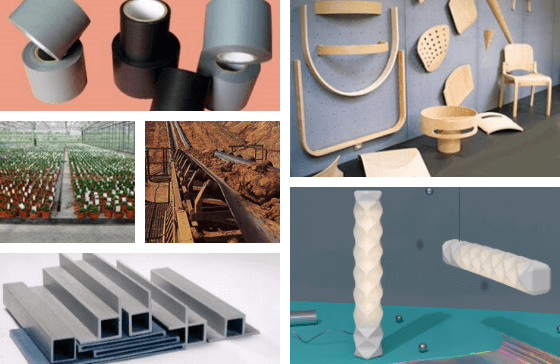
Configuration options:
|
|

